Volkswagen ID.4
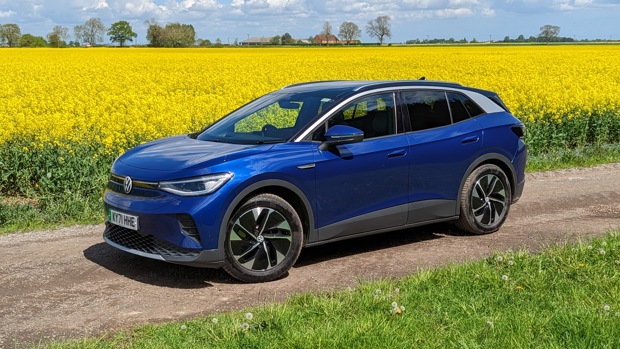
Specifications: Volkswagen ID.4
- Run by: Dan Harrison since March 2023
- Price when new: £48,615 (£58,345 including options)
- Power: 204PS
- Torque: 310Nm
- Range: 314 miles
- Battery capacity: 77kWh
- Claimed economy: 3.9miles/kWh
- Insurance group: 30
- Report 1: Who resurrected the electric car?
- Report 2: How much does it cost to charge a Volkswagen ID.4?
- Report 3: Can you charge an electric car using only solar power?
- Report 4: Longer trips and the chance to use the charging network
- Report 5: Three months in - what works, what doesn't?
- Report 6: The ID.4 gets in the family way
- Report 7: A good time to buy?
Report 1: Who resurrected the electric car?
EVs have been on a long journey over the past 20 years - Is this finally the future we were promised?
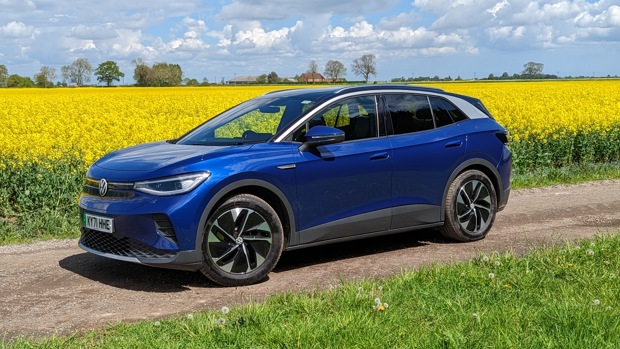
Date: 15 March 2023 | Current mileage: 2386 | Claimed range: 314 miles | Actual range: 260 miles
Cards on the table and full disclosure - I'm a bit of an EV enthusiast.
But it hasn't always been that way and for many years I was something of a cynic, viewing EVs as little more than an expensive novelty - sometimes a bit of a hoot to drive, but you wouldn't want to be saddled with one.
And the car industry also had something of a boy that cried wolf approach to EVs: "Electric cars are coming" is a phrase that I heard repeatedly during the 20+ years that I've been writing about cars.
There have been more than a few false starts - the early 2000s provided a vision of an electrically-powered future with concepts from the main manufacturers and electric start-ups like Th!nk, while GM famously got a large-scale programme off the ground with its EV1 ... and then quickly shut it down - which became the subject of the 2006 documentary film Who Killed The Electric Car? And then things went quiet.
We saw a few car makers dip their feet back in during the 2010s. I remember driving the Leaf prototype in 2010 and being impressed by the tech ... and underwhelmed by the 80 mile range. Then there was the fun, but ludicrously-priced Mitsubishi i-Miev - £37k before grants for a real world range of 50-60 miles.
But, pushed on by Tesla's success, mainstream manufacturers have been putting huge efforts into development and the end result is that EVs have become a lot more convincing in the past five years or so. Range has crept up to sensible levels, the infrastructure has improved and as more models come to the market, pricing - particularly used - is starting to look a little more sensible.
Volkswagen is one of those mainstream manufacturers that's been in the EV vanguard, which brings us to the ID.4 that I'm running for six months.
This version is an ID.4 Family Pro Performance. Yep, that's a bit of a mouthful of a trim level, but actually tells you what this particular ID.4 is in three parts.
Firstly there's 'Family' part. That's it's the mid trim level and fitted with some attractive kit like rear seat air con and USB-C charging, 'Pro' indicates that it gets the bigger 77KWh battery (bigger battery = better range) and 'Performance' shows that it has the more powerful 204bhp motor.
As electric cars become increasingly common expect to see much more of this, as manufacturers try to give consumer-friendly monikers to terms that have previously been confined to your quarterly electric bill.
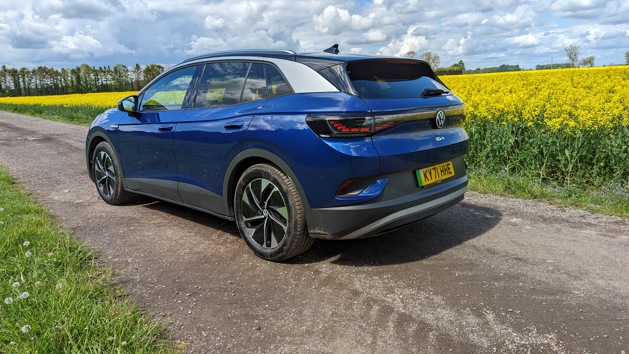
Anyway, back to this ID.4. I really like the look of the interior, which has an upmarket feel to it and is crammed with kit. That 'Family' spec includes heated seats and a heated steering wheel, plus there's all-round parking cameras, wireless phone charging and lane assist, as well as all the usual stuff that you'd expect from a new car in 2023 (climate control, all round airbags, Bluetooth etc).
The styling isn't to everyone's taste and it can look ungainly from some angles, but I think in this striking metallic blue and black roof (a £690 option) and black alloys it's smart and does a good job of looking rather more svelte than you'd expect of the proportions.
The metallic paint isn't the only option, there's a towbar with 13-pin electrics, energy-efficient heat pump, sports package (£360), Assistance pack plus (£2840) and Infotainment Pack Plus (£2750).
And that brings us to that other great bugbear when it comes to EVs: Price. With those options fitted, the total cost of this ID.4 is £58,345 (base price £48,615).
While this is the version with a good spec and decent battery size, that's still a lot of money as an initial outlay and even on a PCP with a £20K deposit over 36 months with a 5.9% APR will be in excess of £800/month.
Cheap electricity used to play a part in cancelling out the initial outlay premium, but soaring energy costs over the past 12 months have made that harder - I'll be taking a look at how that stacks up in following updates.
It's also worth considering that all cars have been increasing in price in the past three years, as production has been cut and supply has become more restricted. It's not just EVs that look expensive these days - even an entry-level Corsa is pushing £20k.
For me, the initial impressions of the ID.4 are good - it's fuss-free to drive, well equipped, looks smart inside and out and feels as though it's going to be simple to live with.
Report 2: How much does it cost to charge a Volkswagen ID.4?
We dig a little deeper into the numbers to work out how much it costs to run an electric car compared to a petrol rival.
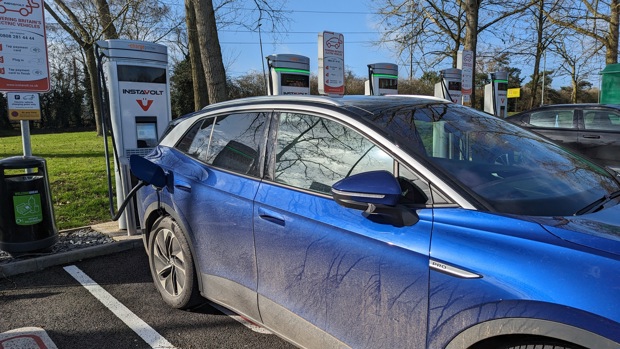
Date: 12 April 2023 | Current mileage: 2745 | Claimed range: 314 miles | Actual range: 263 miles
In my initial Volkswagen ID.4 update, I mentioned that I'm something of a convert to EVs and after many years of false starts, the tipping point has arrived where the benefits now outweigh any inconveniences.
But, I'm in a fortunate position that won't apply to everyone - I have off-road parking, my driving patterns suit home charging (trips over several hundred miles at a time tend to be infrequent and well-planned) and I have three-phase electricity and a 22kWh fast charger. An EV (and this ID.4 in particular with its decent range) fits my circumstances, but that doesn't mean it will suit yours.
Being committed to EVs (we also have a Nissan Leaf) is also giving me the push I need to re-think my approach to energy entirely - after all, the more efficient that I can be, the bigger the savings. From what I gather talking to other EV owners, this isn't unusual - buying an EV is often the start of a broader approach to thinking about how you power your car and home.
We'd already been considering solar, as we have a ground-source heat pump and no gas, so this is our biggest consumer of electricity. We're no Johnny-come-latelies to the heat pump, either, having it fitted in 2016 - it's been almost fault-free the entire time and requires minimal maintenance. We also have a decent amount of south-facing roofspace which could potentially (and neatly) have solar fitted.
This is something we were thinking of doing anyway, even without an EV, but the enticing potential of low cost/free motoring is enticing...and one I'll come back to in a later update.
In the meantime, what I have done is move to Octopus Energy's Octopus Go tariff. Although there's little point in shopping around for energy at the moment, Octopus does offer some clever tariffs that reward shifting your usage around and you can do things like charge and EV at night.
It also has a significant effect on the running costs - you'll have seen plenty of stories in recent months on the vanishing cost incentives of EVs as the price of electricity has risen sharply, yet petrol and diesel has fallen.
I've also had Mienergy's 22kWh charger fitted, which means I benefit from fairly fast charges if needed. I opted for this one for two reasons. It's a smart charger, so you can programme it to come on at different times.
This is perfect for the Octopus Go tariff, which is just 9p/kWh between 12.30am and 4.30am. The Zappi app is also designed to work in conjunction with solar panels and work out when you're generating a surplus and divert into your car, rather than selling it back to the grid (the grid will pay you £0.05 a unit, but a unit is about £0.40 to buy, so the more you can use yourself, the better).
This has a significant impact on the cost of topping up an EV; the example below. Many of the scare stories about the cost of charging your car have been based on the cost you’d pay at public chargers at services. Yes, these have rocketed in price and mile-for-mile often as expensive as petrol/diesel.
BUT you wouldn’t expect to do all of your recharging using this method. The table below shows what a top-up would cost with cheap overnight charging, standard charging at home and what you’d pay at a services.
|
Method |
cost per kWh |
Number of kWh |
Total |
|
Overnight |
0.09 |
40 |
£3.60 |
|
Daytime |
0.39 |
40 |
£15.60 |
|
Services |
0.75 |
40 |
£30.00 |
I've taken that and estimated the costs below based on 10,000 miles and 20,000 miles. The key difference between the two is that I'd expect to do more charging at services the more miles I covered.
|
Method |
cost per kWh |
Number of kWh |
Total |
|
Overnight |
0.09 |
2000 |
£180.00 |
|
Daytime |
0.39 |
400 |
£156.00 |
|
Services |
0.75 |
200 |
£150.00 |
|
2600 |
£486.00 |
||
|
Method |
cost per kWh |
Number of kWh |
Total |
|
Overnight |
0.09 |
4200 |
£378.00 |
|
Daytime |
0.39 |
600 |
£234.00 |
|
Services |
0.75 |
400 |
£300.00 |
|
5200 |
£912.00 |
So how does that compare with something like a Tiguan 2.0 TDI Elegrance SCR DSG with 150bhp?
With a 60l tank, averaging 46mpg (according to Real MPG) and diesel at 153p/litre, each tank should last 606 miles and cost £91.00. That means 10,000 miles will cost approximately £1500 in diesel and 20,000 will be £3000.
|
Diesel cost |
EV cost |
Difference |
|
£1,500 |
£486 |
£1,014 |
|
£3,000 |
£912 |
£2,088 |
The price difference between the diesel Tiguan and ID.4 is £11,755., so you’re likely to break even at the 110,000 mile mark.
That sounds like a lot, but three caveats: Electricity prices are at an all-time high and talk is that these will start to ease this Summer, narrowing the gap with diesel. This is on fuel alone and doesn’t take into account servicing, insurance, depreciation, road tax etc. Thirdly, I’m hoping to bring the fuel cost down further in coming months - but that’s for another time.
Report 3: Can you charge an electric car using only solar power?
With the number of solar panel installations increasing, we see what's needed to charge a car on just solar power.
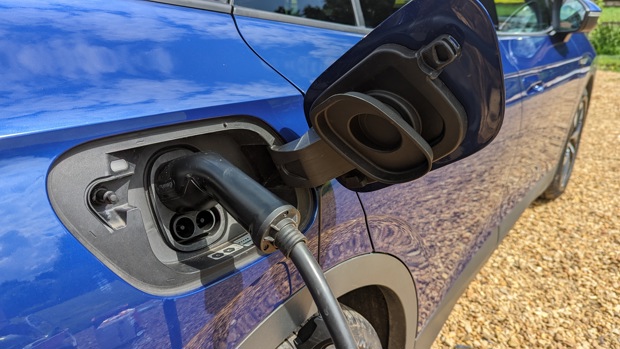
Date: 2 May 2023 | Current mileage: 4826 | Claimed range: 314 miles | Actual range: 263 miles
Galloping electricity prices in 2022 and 2023 has kicked-off something of a solar energy boom as households across the country look to reduce bills and generate more of their own energy.
Industry figures show that more than 50,700 households installed solar panel systems between January and March, more than double on those months in 2022 and the highest figure since 2015, when the last of the government incentives were removed. In total 265 megawatts of power have been added - that's the capacity of half of a coal-fired power station.
And we're now one of those households. We've just had 31 panels fitted with an installed capacity of 12.8kWh. Principally, this is to power our house and, as we're not on gas, to generate as much of our own power as possible. But this kind of set-up is capable of producing some substantial amounts of surplus power and this got me thinking in the run-up to them being installed: Could I in effect use the Volkswagen ID4 in place of a home battery system, absorbing the excess when it's produced to cut down on charging costs and ideally bring costs down to zero?
In preparation for this, I did a bit (well a lot) of research into home EV chargers that would be well suited to the task. I settled on the tethered version of British-made Zappi V2 with built-in wifi and an LCD control panel. What it lacks in form it more than makes up for in function. That large block of black and grey plastic is super-sturdy and has a built-in cable tidy for when it's not being used and it's smart too and through the app you can schedule charging sessions to make the most of cheaper overnight tariffs and get a clear view of how much electricity you're importing. But it's how it interacts with solar panels that sold it to me. With the right set-up, Zappi will monitor how much energy is being generated by the panels and you can tell it to charge the car only when there's a surplus. That means that it isn't competing with your household appliances for the solar energy and only kicks in when there's too much being produced.
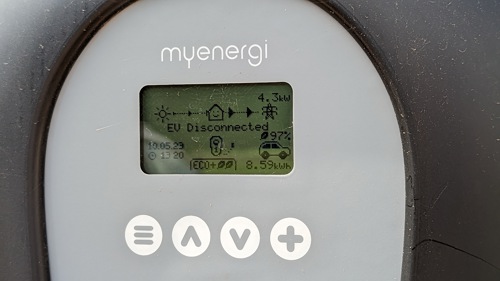
The installation of solar panels is impressively swift. Most standard installations can go up in a day; ours was a bit bigger, a little more complicated and a the weather wasn't playing ball, so ended up taking just over two and a half days ... incredibly quick for such a sophisticated piece of kit.

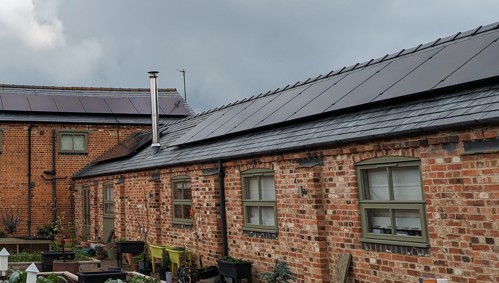
From the moment the system was commissioned, it has started to generate power, even at this time of year we can easily get 50kWh from the panels and 20-25kWh if it's cloudy. Come the summer, we should see peaks in excess of 80kwh per day and around 12,000kWh per year.
This transforms the economic viability of the ID4, creating a situation where it's possible to smartly run a car for nothing in terms of fuel cost. I’m finding that the ID4 takes somewhere between 24-36 hours to charge from nothing to 100% full using the solar-only option - that’s a range of around 250 miles. This suits the type of driving that I do, which is a couple of long 200+ miles trips per week, punctuated with smaller more local trips. That allows for plenty of parked-up time to recharge.

Right, back to the maths. Remember those tables from my previous update? I have changed them to reflect the free electricity generated by the solar panels and weighted it in favour of the Summer months, with the expectation that the longer brighter days in late Spring-early Autumn will provide enough power to charge for free.
I estimate this will reduce the fuel costs for 10,000 miles by £252 and 20,000 miles by £354. The need to use more expensive services from time-to-time is now the main expense and shows why range is so vital to making the economic argument stack up - not just to reduce the need to stop to charge. If I can start to replace more of the very expensive charging at services with charging at home (ideally solar), these figures will improve further.
|
Method |
cost per kWh |
Number of kWh |
Total |
|
Overnight |
0.09 |
40 |
£3.60 |
|
Daytime |
0.39 |
40 |
£15.60 |
|
Services |
0.75 |
40 |
£30.00 |
|
Solar |
0.00 |
40 |
00.00 |
I've taken that and estimated the costs below based on 10,000 miles and 20,000 miles. The key difference between the two is that I'd expect to do more charging at services the more miles I covered.
|
Method |
cost per kWh |
Number of kWh |
Total |
|
Method |
cost per kWh |
Number of kWh |
Total |
|
Overnight |
0.09 |
500 |
£45 |
|
Daytime |
0.39 |
100 |
£39 |
|
Services |
0.75 |
200 |
£150.00 |
|
Solar |
0.00 |
1800 |
£0 |
|
|
|
2600 |
£234 |
|
|
|
||
|
|
|
|
|
|
Overnight |
0.09 |
2000 |
£180 |
|
Daytime |
0.39 |
200 |
£78 |
|
Services |
0.75 |
400 |
£300 |
|
Solar |
0.00 |
2600 |
£0 |
|
|
|
|
|
|
|
|
5200 |
£558 |
And now to revisit that Tiguan 2.0 TDI Elegrance SCR DSG with 150bhp comparison:
With a 60l tank, averaging 46mpg (according to Real MPG) and diesel at 153p/litre, each tank should last 606 miles and cost £91.00. That means 10,000 miles will cost approximately £1500 in diesel and 20,000 will be £3000.
|
Diesel cost |
EV cost (inc solar) |
Difference |
|
£1,500 |
£234 |
£1,266 |
|
£3,000 |
£558 |
£2442 |
The addition of solar puts several hundred pounds per year back in my pocket - almost £500 over 20,000 miles over a diesel Tiguan. Should services prices fall again in coming months as the cost of electricity drops, that lead for the ID4 should stretch out even further.
However, to answer the question I posed at the start: Can you charge a car with just solar panels. Yes, but... You're going to need a powerful system. The average size of installation is about a quarter of mine, which means much less surplus power available and much longer charging times. But, for those who can keep their cars plugged in, it's makes much more sense to charge your car's battery rather than send that energy off to the grid.
Report 4: Longer trips and the chance to use the charging network
We put some long distance trips to the test.
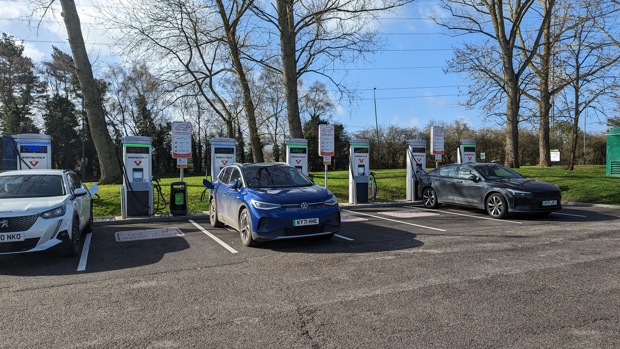
Date: 30 May 2023 | Current mileage: 6326 | Claimed range: 314 | Actual range: 263 miles
The first few updates about my time with the Volkswagen ID4 have been about the economic argument and what sort of lifestyle you need to have in order for it to work. The hurdles to owning, running and driving an electric car are often more in the mind than based in reality - and making the financial case is often the first domino to fall. Make the numbers work and the other ‘issues’ suddenly become less important.
Range is another biggy. Electric cars have a reputation for lacking in range and not being up to longer trips - and quite rightly so. The first 10-15 years of EV availability saw ranges of around 80-120 miles for most models and, in reality, these were actually much less. But the pace of development in the past two or three years has been breathtaking and now it fairly normal for cars to have a 300+ mile range. The Volkswagen ID4 is one of those, with a range of 314 miles on paper, which at the moment is translating to 250-260 miles in reality, with air con, heated seats etc on.
So we’re putting the ID4 to its first proper ‘real life’ range test - a mini road trip to the north east of England (a Christmas present for my wife), starting in South Lincolnshire, with stops in York, Newcastle-upon-Tyne and Hexham, before coming back the long way via Tebay services. Total milage is just shy of 500 miles.
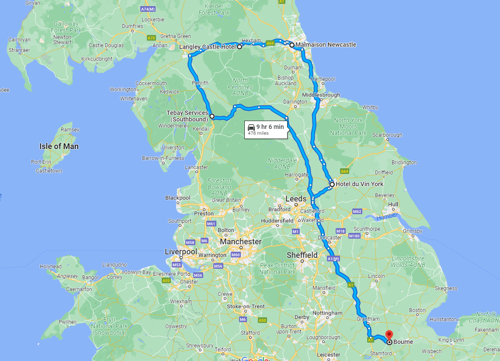
Charge Stop 1: Nunnery Lane, York
- Operator: BP Pulse
- Type of charger: 50kWh
- Cost to charge: 45p/kWh
- Waiting time: 0 minutes (parked up and plugged in)
Our first leg was relatively quick, taking us from South Lincolnshire to York in just under a couple of hours. The Hotel didn’t have a dedicated EV charger in the car park, so we opted to park up in one of the council-run car parks, parked up for an hour and a half and went for lunch. We got to York early, so we were able to be as leisurely as we liked.
By the time we returned, the ID4 had just completed a full charge and we drive to our hotel (less than a mile away) ready for the next leg. Simple, drive-up, fast charging - and pleasantly surprised by the cost: 45p/kWh is much cheaper than many other fast charge outlets (though a far cry from the cost just 12 months ago).
Charge Stop 2: Gateshead Tesco Extra
- Operator: Podpoint
- Type of charger: 22kWh
- Cost to charge: 44p/kWh
- Waiting time: 5 minutes
For such a large city, the fast charging network in and around Newcastle is surprisingly poor for such a large city. I do most of my driving in the south and the difference in availability is noticeable - reminding me of the SMMT’s report from 2022 that highlighted a developing north/south divide:
“Although most current plug-in car users charge at home, public chargers remain critical to consumer confidence and are still relied upon by many commercial fleets, as well as the third of British households that do not have designated off-street parking. Furthermore, drivers face a growing regional divide in chargepoint availability. At the end of 2020, the ratio of electric cars to standard public chargers was 1:37 in the north of England, compared with 1:26 in the south – and in 2021, the ratio deteriorated significantly in the North to 1:52, compared with 1:30 in the south.
To give all drivers the confidence they will be able to charge as easily as they refuel, wherever they live or work, the sector is proposing a nationally coordinated and locally delivered infrastructure plan that puts the needs of consumers first, while also giving chargepoint operators and local authorities certainty to install the right number of the right chargers in the right places ahead of need, across every part of the UK.”
In the end, with no chargers near our city centre hotel, we opt for a pit-stop at the Tesco Extra in Gateshead, where we were able to use a 22-kilowatt-hour charger from Pod Point. Though it didn't fully meet our needs, it gave us a top-up, and we continued our search for a faster charger to complete the rest of our journey. This required use of the Podpoint app, but with it already installed and topped-up, this wasn’t a big issue - this time.
Charge Stop 3: Metro Centre
- Operator: Zest
- Type of charger: 11kWh
- Cost to charge: 50p/kWh
- Waiting time: 0 minutes
This is another stop where an app is needed to pay - despite this being (an impressive) new installation. Why an app for charging is needed as the roll-out of EVs accelerates, I don’t know, but I’m of the firm belief that it should stop and contactless should be the standard. If you don’t have the app already installed, it takes a good 5-10 minutes to get up and running. Totally unnecessary and I’m unlikely to use this app ever again, as I’m only visiting this location once and the firm’s network is pretty sparse.
Despite that rant, this installation at The Metro Centre is a real glimpse into the future, with 11kW chargers almost as far as the eye can see. The idea is that you park up, charge, spend three or four hours, which is what we ended up doing, giving plenty of charge to continue our trip with.
Charge Stop 4: Langley Castle
- Operator: Owner
- Type of charger: 7kWh
- Cost to charge: Free
- Waiting time: 0 minutes

A nice easy one, this. Parked up, plugged-in, and fully charged (slowly overnight) - for free. May have been a different story if another EV had been in the space, but we were the only ones there overnight. This will be something that we’ll have to see more of in the near future - lots of slow chargers in hotel car parks, so that cars can recharge at the same time as their drivers do…
Charge Stop 5: Tebay Services
- Operator: Gridserve
- Type of charger: 50kWh
- Cost to charge: 69p/kWh
- Waiting time: 30 minutes
We took the A66 out of Northumbria and into Cumbria, though some twisty, mountainous routes that were partly in sunshine and partly very dark and misty. Really not the kind of place that you want to run out of charge, so I’m thankful that we were fully charged.
At Tebay services, there’s two areas of chargers Tesla superchargers on the southbound (the way we were heading, but we can’t use the Tesla superchargers) and Gridserve on the northbound side. But, this wasn’t an issue as there’s a road that links the two and it’s very well signposted for EV owners.
But it’s busy, evidenced by the construction work on a new bank of EV chargers for later this year. We have to wait in the car and wait for another owner to finish - 30 mins, so end up staying at the services longer than anticipated. Thankfully, as it’s Tebay, and we’re in no rush, this isn’t a problem. No apps either - this chargepoint was contactless.
And, from there, it’s 200 miles back home. We do it in one stint and almost four hours, getting back with 50 miles to spare.
This journey showed that with proper planning and knowledge of good charging locations with both ultra-fast and semi-fast chargers, it is possible to complete long journeys without significant interruptions. We were particularly surprised by the poor charging network in and around Newcastle city centre.
The Volkswagen ID4 itself didn’t miss a beat and had a realistic range of 250-260 miles. This was more than enough for these legs without ever worrying about range anxiety. The lion’s share of the trip was on the motorway, where the ID4 is quiet and incredibly comfortable with an excellent driving position and multi-adjustable, comfortable seats. Perfect for these kinds of long distance journeys.
While the journey wasn’t entirely fault-free, neither was it anything like some of the screeching headlines of recent months. But, then again, we weren't in a rush on this trip and could afford to take our time. We may have felt different if we’d needed to be in places at a set time.
Report 5: Three months in - what works, what doesn't?
I'm three months into my six-month stint with the Volkswagen ID.4, so it's a great opportunity to take stock of what works - and what doesn't. Is it proving to be easy to live with or are those niggles starting to grate?
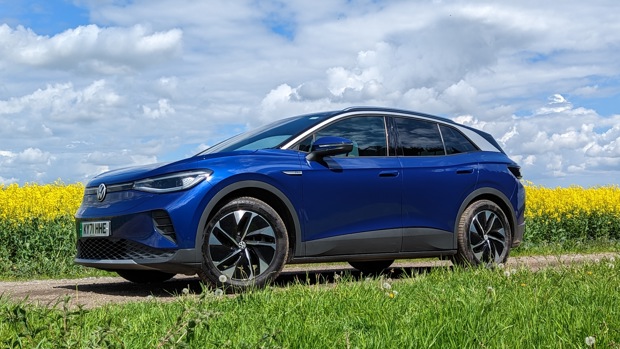
Date: 14 June 2023 | Current mileage: 6981 | Claimed range: 314 | Actual range: 263 miles
Comfort
One of the hidden pleasures of driving an electric car is just how quiet they are and that's no different with the ID.4. The electric motor is close to silent and far, far quieter than you would get with an equivalent petrol or diesel engine. That smoothness extends to the overall driving experience: the electric powertrain provides instant torque, making acceleration responsive and seamless, plus the ID.4 has a pretty adept suspension system that makes light work of road imperfections and provides a comfortable ride - important for reducing vibrations and impacts felt inside the cabin.
There’s also plenty of pace inside for both driver and passengers - as you’d expect from a car with an SUV silhouette - with decent headroom and large, supportive seats. It’s also very well made, with good quality materials used throughout.
I’ve even come to like the heads-up display on the windscreen. Various manufacturers have tried with this over the past 20 years or so with differing results, but in this incarnation it gives you useful information, is pretty clear and doesn’t feel like it’s blocking the view of the road.
Volkswagen ID light strip
While not unique to the ID.4 (the ID.3 gets it as well), one of the stand-out features available is Ambient Lighting. This not only gives you the opportunity to customise the car’s interior colour depending on your preferences, but also for it to communicate with you when you’re on the move.
A slim light strip under the windscreen gives you subtle clues as to what the car is up to, using different types of light. That could be to tell you if the car is good to go, which way it's turning according to the GPS, or if the battery's getting a recharge.
The strip itself has 54 LEDs running the length of the front window. You can only see it from the corner of your eye or at certain angles from outside. With different colours and patterns, ID. Light gives signals that the driver and front passenger pick up easily, so they can focus more on the road and less on distractions.
Another example of the colour A little “welcome” light show in white and blue lets you know the car's ready to roll. Handy, right? Especially since electric cars don't make those engine noises like their fuel-burning cousins. The colours flip when you hop out of the car again.
This is the kind of innovation that can often feel like a gimmick or added for the sake of it. That’s not the case here - it’s understated, but after a while the signals that it gives become second nature - and genuinely useful.
Range and consumption

I’ve covered this in previous updates about charging costs and longer journeys, but the ID.4 benefits from a range that makes it very easy to live with. We have to bear in mind that it’s early Summer and that will be flattering what’s achievable, but even so 260-270 miles on one charge is pretty standard. It means I can leave my house on a full charge and know that I can drive for four to five hours without having to charge.
I’ve previously been used to electric cars with a 150-200 mile range. 250+ suddenly transforms an EV from being good for everyday driving into something that you’re happy to tackle longer trips with.
Practicality
This is an easy car to live with and very versatile. Loads of room in the boot (we have a large dog, so this is welcome), plus the seats fold flat for those trips to furniture shops etc.
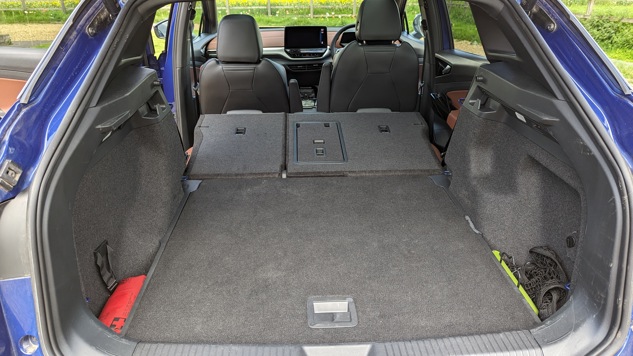
Not so hot
So, what's not working so well? Well, there's a few electrical gremlins here and there - phantom warning lights at times that appear at start-up and then disappear almost as quickly as they arrived - something I may look into further in a future update. Then there's the over-reliance on virtual switches and hiding too much behind menu screens. I'm no luddite, but I do find it unnecessarily complicated to do simple things in the ID.4 like change the air con temperature or increase the fan speed or direction. It involves pressing the button 'Clima' and then navigating various menus - there has to be a better way for simple things like this. I consider myself pretty techy and it perplexes me, so will really be an issue for those who prefer things more conventional. And, while you can learn how it works and master, why should you for something that should be so simple?
But, overall, this is a car that’s proving pretty easy to live with.
Report 6: The ID.4 gets in the family way
The ID.4 meets a new arrival.
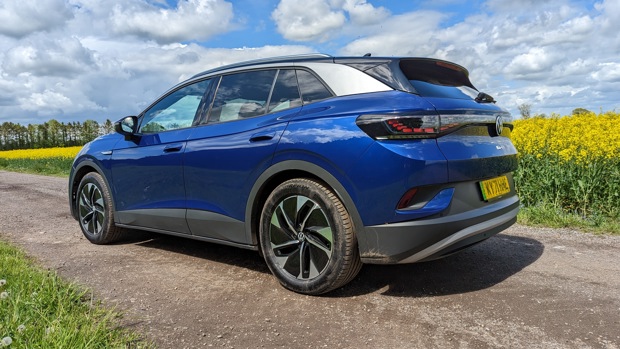
Date: 20 July 2023 | Current mileage: 7293 | Claimed range: 314 | Actual range: 270 miles
That headline above is a long-standing cliché from the world of motoring journalism generally used when an estate version of an existing model is launched.
I may even have used it a few times in the past (I definitely have), but this time using it entirely appropriately, as our lives changed entirely this month as we welcomed our son into the world. He’s our first child and, for the first time, I’m starting to look at cars with an entirely different outlook and one that will be familiar to anyone else who has started a family.
The first test for the ID.4’s new role in family life came before our son was born - getting him to the hospital. Remember that smooth suspension that I mentioned in a previous update. My wife reports that it was much appreciated on the way to the hospital itself … I put it down to my driving.
Then it was onto one of the most important parts of the first few days of a new-born, getting a car seat properly fitted for the first time.
We opted for a Cybex Cloud Z2 i-Size. This is the German firm’s upgraded version of the award-winning Z i-Size, with similar - but enhanced - features.
Most significant of those improvements is the recline function. While the original Cloud Z allowed adjustment to a flatter angle only when connected to a pushchair chassis, the new model offers the flexibility to semi-recline within the car and lie completely flat outside the car.
These days a car seat can’t just be a car seat, but needs to integrate into a “travel system”. Despite by initial scepticism and cynicism, this actually works really well. There’s an Isofix base (which we opted for, but you can secure with a belt) and adapters which mean you can fit the car seat straight on to the pushchair chassis without having to take the baby out of the seat.
When it come to getting it fitted into the ID.4, it really is child’s play (dreadful pun intended). There are a couple of arms on the base that clip into easily-accessible Isofix points and a leg comes down to the floor to securely hold the seat in place. A series of indicators on the base will show if it’s properly fitted and the seat is securely in place. As the ID.4 is so spacious inside, there’s still plenty of interior space for other passengers and a good degree of backward slide maintained for the rear seats. Its height off the ground and wide door openings makes it a doddle to get the seat in-and-out too.

Things I really like about the Cloud Z2 design are the UPF50+ canopy, promising protection from the sun, wind, and noise and the seat's curved bottom, allowing for gentle rocking, stood out as a thoughtful feature that could potentially extend a baby's sleep after a car ride.
Safety features, a crucial aspect of any infant car seat, include the Linear Side-impact Protection (L.S.P.) System with wings designed to enhance protection in side collisions. While Frances found this reassuring, she suggested that automatic deployment or brightly coloured wings could improve user engagement.
Weighing 4.6kg, the Cybex Cloud Z2 is relatively light compared to similar seats, although Frances found it somewhat heavy to carry, particularly with her baby inside. Despite this, she praised the sturdy and durable construction, expecting it to withstand extensive use. The machine-washable fabric covers add to the convenience of maintaining the car seat's cleanliness.
We got ours as part of a bundle with a pram/pushchair, base and a whole bunch of stuff to save overall. But, opt for it on its own and prices start for £339.
Although I’ve fitted numerous car seats over the years at Honest John, which meant it was probably easier for me than most when it came to doing it ‘for real’, I’ve never really considered the space needed for a pushchair - or how heavy they can be and how important it is for the boot to be not too far off the ground or a lip on the boot. I’ve been a bit spoilt in this regard - the ID.4’s boot is wide, easy to access and not too far off the ground. Pretty well set up for the family life.
Just as well - overnight, everything changed for me - not least with what I look for first in a car.
Report 7: A good time to buy?
Used values of EVs have been in the news a lot recently - does that make it a buyers' market.
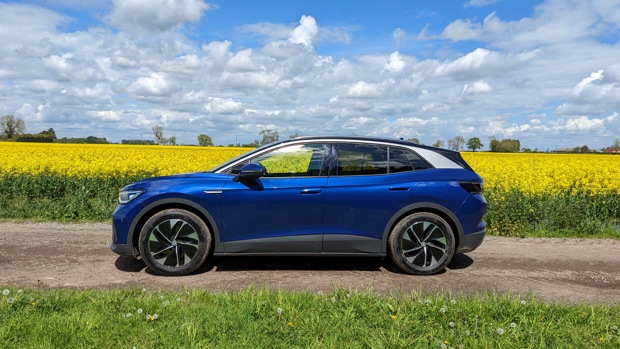
Date: 10 August 2023 | Current mileage: 7632 | Claimed range: 314 miles | Actual range: 263 miles
What a difference 12 months makes. Just a year or so ago, EV values were riding high, with low availability and high demand, EVs commanded a premium.
And then a few things happened. Suddenly a slew of new EV models entered the market from both established manufacturers and largely Chinese new entrants, so there was more choice (and supply) than ever, the Government announced the phase-out of the few incentives available (inc £0 VED) and - crucially - electricity prices spiked, removing the strong financial incentive that had been around for years.
It has led to interest in buying EVs collapsing, dealers reporting that they’re unable to shift them on and values dropping fast as a result.
Despite calls for scrappage schemes and other incentives, the government hasn’t reversed any of its EV plans. But it has helped to stabilise the energy market and that, combined with global falling prices, has meant that last year’s energy shock is slowly working its way out.
The automotive market is starting to react too. One of those is something that was unthinkable this time last year - interest free credit. Over the Summer Volkswagen ID. models are offer with 0% finance on a PCP, reducing monthly payments by up to £33 for an ID.3, £97 for an ID.4 and £101 for an ID.5, when compared with previous offers.
All variants and trims of the ID.3 (outgoing model), ID.4 and ID.5 are included in the offer, for which a minimum five-per-cent deposit is required and the PCP maximum term is 36 months.
But buy used and there’s even bigger savings to be made - with used prices starting to look pretty attractive and the financial argument for an ID.4 stacking up much better against a petrol or diesel-powered equivalent.
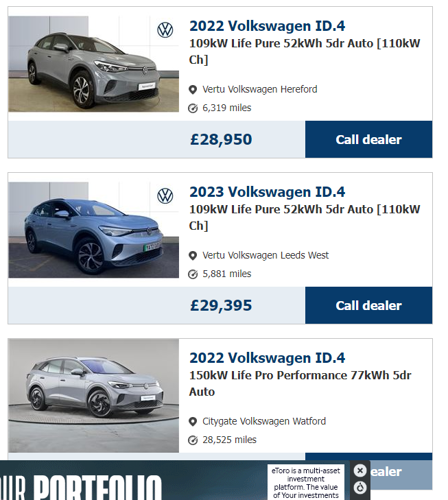
Over at Honest John Cars For Sale, there’s currently year-old (and less) examples for sale from £25k for the 109kw motor / 52kWh battery version and between £30-35k for the 150kw motor / 77kWh battery version that I’m currently driving. That’s savings of between £15-20k on the current list price - the equivalent of something like a year-old used Fiesta. We’re talking substantial sums here.
It means that if you’re in the market for an EV and it suits your house and lifestyle, the rational argument for buying one is starting to build again. The Volkswagen ID.4 has a lot to offer as a capable small family SUV and with a £25-£30k price tag is suddenly a different proposition to a £45-£50k premium EV. If nothing else, if you’re in the market for something this size - EV or conventionally powered - it’s worth taking a look, having a drive and running the numbers, because that’s an affordable way into a really classy EV.
